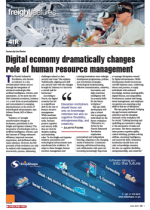The South African Revenue Service (Sars) recently encountered severe failures in its online platform systems. This unfortunate incident was a stark reminder of our reliance on technology. However, amidst the chaos, Sars demonstrated foresight by implementing an operational failover plan, ensuring the smooth facilitation of trade while actively seeking a long-term technological solution.According to Michael Henning, sales manager at Easy Clear, while disruptions such as these underscore the significant risks associated with our increasing dependence on digital infrastructure, it also brings opportunity. “With an increasing volume of information being gathered on the supply chain, particularly about our ports of entry and exit, private sector stakeholders have begun to unlock intriguing findings. The analysis of this data has the potential to alleviate, or at the very least identify, constraints within the supply chain. As these challenges come into focus, it becomes evident that addressing them requires collaborative efforts from stakeholders across the industry to discover and implement sustainable solutions that can alleviate the burdens crippling our supply chain.”It is crucial to note, says Henning, that these challenges do not arise solely from the Fourth Industrial Revolution (4IR). However, the solutions to these challenges may be found within the realm of 4IR. “Our growing dependency on technology can be viewed as a significant challenge, but its risks can be mitigated through the upskilling and education of existing human resources. By equipping individuals with the necessary skills to cope with potential system failures, we can effectively manage and minimise the impact of recent incidents, as witnessed firsthand.”He says while technology dependency poses a risk, it also holds the key to potential solutions. “To tackle the constraints hindering our supply chain, industry-wide stakeholders must collaborate and capitalise on the transformative power of 4IR. By embracing this collaborative approach and nurturing our human resources, we can forge a resilient supply chain system that adapts to future challenges.”The trend to digitalise will continue. “Easy Clear, for example, now offers B2B and B2C solutions through our API, allowing for a more seamless experience for the user, and more importantly, an increase in productivity by eliminating repetitive data capture and reducing – if not eliminating – error. The utilisation of real or near real-time data gives our clients greater visibility in order to track activities better. Our integration with online accounts applications, such as Xero and Sage online, gives management a true ‘business in your pocket’ model, emphasised through the mobile applications we are introducing. The drive to digitalise business processes as much as possible in the logistics supply chain will continue to be the trend.”According to Henning, Easy Clear has been at the forefront of the technological revolution from the onset and an early adopter of technology.“The evolution of the Easy Clear software system, from its beginning as a locally hosted, windows-based solution, into a modern SaaS (Software as a service) model, has its roots in what is now known as 4IR. As a software company, we are always exploring different ways to solve practical business problems for industry and apply this to our own business model.

